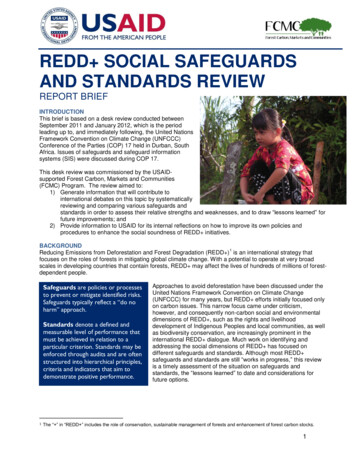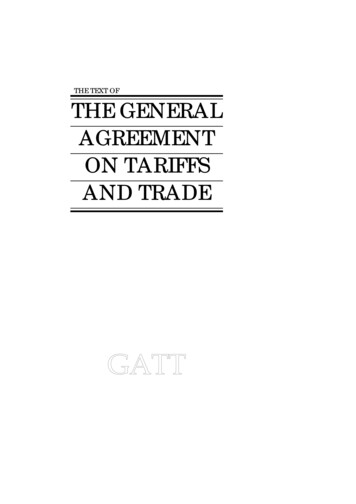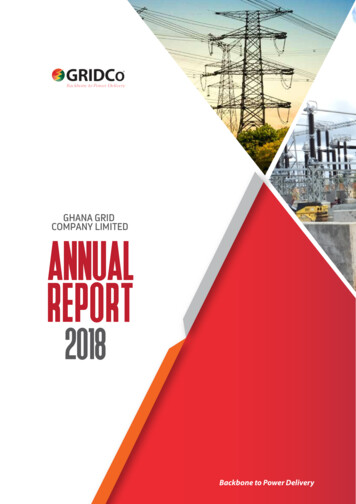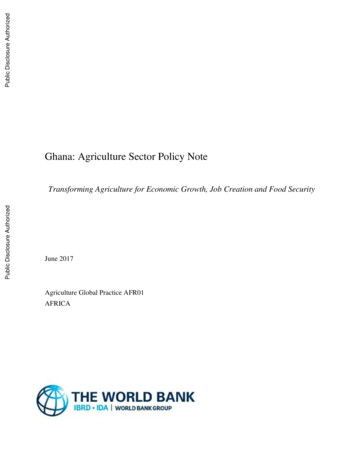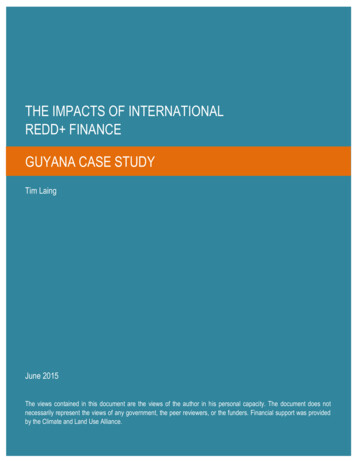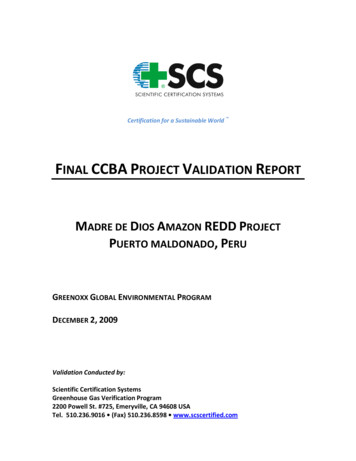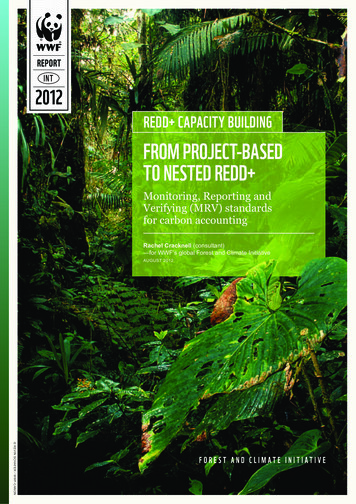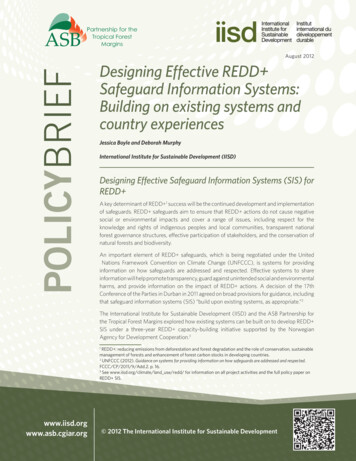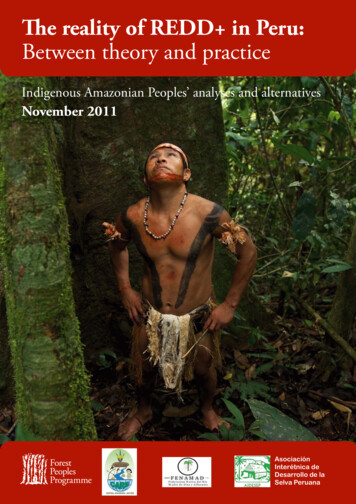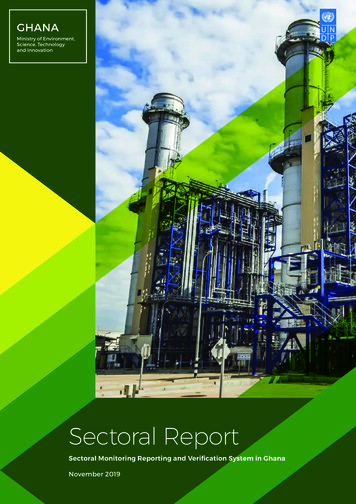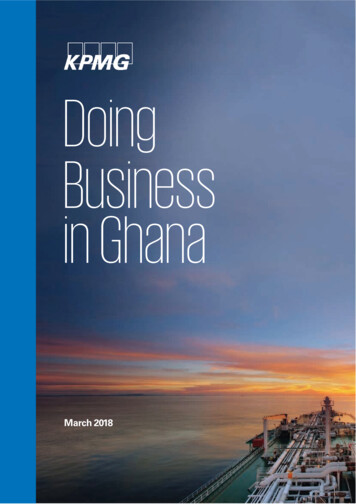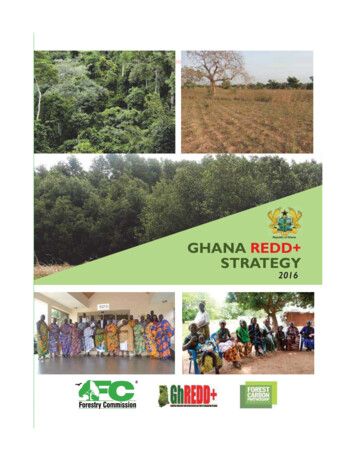
Transcription
GhanaGhaGhGhhaannaa REREDD RE StStrategytratattegyeegggyyRepublic of GhanaGHANA REDD STRATEGYrategy: 2016-20401Page 1
Ghana REDD StrategyGhana REDD Strategy2016 - 2035Page 2
Ghana REDD StrategyCover Photos:(TL)(TR)(M)(BL)(BR)Kakum National Park, Central Region of GhanaA cross section of the shea landscape, Zebilla in the Upper East RegionMangrove establishment at Songhor Ramsar Site, Ada.Consultation with traditional authorities on the REDD process in GhanaConsultation with local community members at Damongo during the 2014 REDD RoadshowPage 3
Ghana REDD StrategyACKNOWLEDGEMENTSThe process adopted for the development of Ghana’s REDD strategy benefitedimmensely from invaluable contributions, comments and feedback from severalstakeholder groups and individuals. The National REDD Secretariat (NRS) ofGhana is grateful to all stakeholders for their strong collaboration and commitmentexhibited towards completion of the document.The NRS wishes to express its gratitude to the Forest Carbon Partnership Facility(FCPF) for their continued support of Ghana’s REDD readiness process andparticularly for the technical and financial support they offered towards completionof the document. The NRS is also grateful to the National REDD Working Group,the REDD technical sub-working groups as well as key government ministries andagencies including the Ministry of Lands and Natural Resources, the Ministry ofEnvironment, Science, Technology and Innovation, the Environmental ProtectionAgency, The Forestry Commission and Ghana Cocoa board for their excellentinsights that have greatly enriched the document.The NRS also wishes to acknowledge the contributions of key subject matterspecialists from Civil Society Organisations and Academia during the review andfinalization of the document.Finally, the NRS acknowledges the World-Wide Fund for Nature (WWF) whosepublication titled: ‘WWF Guide to Building REDD Strategies’ was adapted forstructuring the main sections of the document.Page 4
Ghana REDD StrategyFOREWORDThis updated National REDD Strategy demonstrates theprogress that Ghana has made in the preparatory processtowards REDD implementation. It is therefore an honourfor me to present this important national document to youon behalf of the Government of the Republic of Ghana.Ghana’s REDD Strategy was developed through the hardwork and support from several stakeholders and national experts. These valuablecontributions and commitment to the process provide ample evidence of Ghana’sdetermination to embrace and recognize REDD as one of the pathways for soundmanagement of our natural resources.Through our partnership with the Forest Carbon Partnership Facility (FCPF),Ghana commenced REDD readiness activities in 2008 with the submission andacceptance of our REDD Readiness Plan Idea Note (R-PIN). During this period,REDD had only emerged as a concept in global climate change negotiationsunder the ambit of the United Nations Framework Convention on Climate Change(UNFCCC). Presently, Ghana has put in place a favourable enabling environmenttowards REDD implementation, making the country, one of the global forerunnersin the REDD process.As Ghana makes positive strides in the REDD process, it has become increasinglyevident that the mechanism will provide multiple benefits that will safeguard thecountry’s forest and wildlife resources and ensure that there is optimal and sustainableflow of benefits to all segments of our society. The contemporary challenges whichthreaten Ghana’s forestry sector include an upsurge in illegal mining and loggingactivities; wildfires; and unsustainable agricultural production. The national REDD strategy therefore outlines large-scale sub-national interventions that seek to addressthe key drivers of deforestation and forest degradation within the jurisdictionalcoverage of the selected programmes.As part of ongoing collaboration with the FCPF, major advances have been madetowards developing Ghana’s first sub-national REDD programme. This EmissionsReduction Programme christened the GCFRP. The Ghana Cocoa-Forest REDD programme seeks to significantly improve cocoa yields through the adoptionPage 5
Ghana REDD Strategyof environmentally sound climate-smart practices with an objective of curbingdeforestation and forest degradation in cocoa landscapes whilst addressing otherdrivers of deforestation and forest degradation in Ghana’s High Forest Zone.Ghana’s REDD Strategy is also well-anchored within a very favourable policyenvironment. In our recent past, Ghana has adopted key policies including theNational Climate Change Policy (2013) and the National Forest and Wildlife Policy(2012) which provides a sound basis for REDD implementation.In conclusion, I wish to reiterate Ghana’s commitment to translate the nationalREDD strategy into actionable interventions implementation of which will usherGhana into a low-carbon development pathway and enhance the integrity of ourenvironmental resources. The effective implementation of REDD will also enableus to contribute meaningfully to global efforts targeted at addressing climate changewhilst providing significant opportunities to millions of Ghanaians whose livelihoodsare dependent on well-functioning forest ecosystems.SAMUELUELL AFARI-DARTEYAFAARIR -DARARRTCHIEFCOMMISSIONF EXECUTIVE,EXECUTUTIVVE, FORESTRYFPage 6
Ghana REDD StrategyPREFACEThis maiden revision of Ghana’s national REDD strategy was necessitated by majoradvances and experiences gained on REDD after the completion of the initialversion in January, 2015.This revised strategy document takes into cognizance the outcomes of the historicclimate change agreement adopted at the 21st Conference of the Parties (COP 21)to the United Nations Framework Convention on Climate Change (UNFCCC) inParis in December, 2015. The Paris Agreement signals a significant milestone inthe recognition of the role of REDD in the fight against climate change. Article 5of the Paris Agreement admonishes countries to implement and support REDD interventions whereas the Agreement also provides guidance on the approaches tobe adopted by countries to fund REDD interventions (Decision 55/ CP. 21).The revision of the document was also strongly influenced by the significant progressmade in-country in the REDD process in the period following the completion ofthe initial strategy document. During this period, Ghana transitioned from REDD readiness to an intermediary stage where REDD demonstration activities (underthe Forest Investment Programme) and development of Ghana’s first sub-nationalREDD programme (i.e. the Ghana Cocoa Forest REDD programme) are beingconcurrently undertaken. These advances have contributed greatly to a clearerunderstanding of the form that REDD implementation will take in Ghana andhave also shaped thinking on the key approaches to be adopted for addressing thedrivers of deforestation and forest degradation in a manner consistent with nationalcircumstances. Further inputs for the revision of the strategy document alsoemanated from the deliberations that took place during the formulation of a Ghana’sPlantation Strategy implementation of which will form an integral component ofGhana’s REDD process.In revising the strategy document, a multi-stakeholder participatory approach wasadopted to ensure that the revised document reflects current national thinking andaspirations on REDD whilst ensuring consistency with emerging internationalbenchmarks and guidance on REDD .The National REDD Secretariat is keen to engage with the wide array of stakeholdersthat are committed to effective and efficient implementation of this strategy to reversethe spate of deforestation and forest degradation in Ghana and its dire consequences.Page 7
Ghana REDD StrategyTABLE OF CONTENTSAcknowledgementForewordPrefaceList of FiguresList of TablesList of AcronymsExecutive SummaryBackgroundSections of the strategy document34699101414151.INTRODUCTION1.1The Global Context1.2The Ghanaian Context1.3Ghana’s REDD Vision, Goals, Criteria and Principles1.4The Strategy Development Process1.4.1 Consultations in the Strategy Development Process2021222427272.ACHIEVING REDD 2.1Drivers of Deforestation &Forest Degradation2.2Key interventions to reduce deforestation and degradation2.3Scope of REDD 2.4Ghana’s REDD Implementation Strategy2.4.1 Emission Reductions Programme for the CocoaForest Mosaic Landscape2.4.2 Emission Reductions Programme for the Shea Landscape ofthe Northern Savanna Woodland2.5Time Frame and Phases2.6Financing REDD 2.7REDD Payments and Benefit Sharing2.7.1 Existing Benefit Sharing Arrangements in Ghana2828313334GOVERNANCE OF REDD IN GHANA3.1Institutional Arrangements3.1.1 National Level Management & Oversight3.1.2 Technical & Analytical Roles and Responsibilities3.1.3 Sub-National Institutional Arrangements for Implementation50505253563.Page 8394042434749
Ghana REDD StrategyTABLE OF afeguards Institutional ArrangementsPolicy and Legal EnvironmentAlignment with PoliciesGhana’s Legal Framework, Challenges for REDD andStrategy to Resolve Key IssuesSocial & Environmental SafeguardsSafeguard Information SystemMainstreaming GenderFeedback and Grievance Redress Mechanism (FGRM)Institutionalizing multi-stakeholder dialogue processfor REDD TRACKING REDD 4.1MMRV System4.1.1 Forest Definition4.1.2 Forest Monitoring System4.1.3 Measurement4.1.4 Reporting and Verification4.2Reference Level4.3REDD Information System & APHYANNEX8081Annex 1: Relevant national policies, Strategies and developmentpriorities and link to current National REDD Strategy81Page 9
Ghana REDD StrategyLISTFIGURESList of OFFiguresFigure 1: Ghana’s strategic options for addressing drivers ofdeforestation and degradationFigure 2: Criteria for assessing strategy optionsFigure 3: Interventions and activities to promote REDD impactsFigure 4: The components of REDD in GhanaFigure 5: Map of Ghana’s forest ecosystemsFigure 6: Priority jurisdictional programmes for implementationFigure 7: Potential programmatic landscapes for REDD implementationFigure 8: Eco-zone landscape of the Emission ReductionsProgramme for the Cocoa Forest Mosaic LandscapeFigure 9: REDD preparation phaseFigure 10: Ghana’s REDD financing strategy for preparation,implementation and paymentsFigure 11: Ghana’s national REDD governance and implementationarchitectureFigure 12: Institutional roles and responsibilities ofGhana’s MMRV systemFigure 13: Steps in Ghana’s FGRM25252627293031323537424456LIST OF TABLESTable 1: Direct and Indirect Drivers of Deforestation and Degradation 23Table 2: Ghana’s strategy interventions and options26Table 3: Overview of relevant National Policies, Strategies andDevelopment priorities that align with Ghana’s REDD Strategy48Page 10
Ghana REDD StrategyLIST OF rican Carbon RegistryAvoided DeforestationAvoided Forest DegradationAlternative Dispute ResolutionBiodiversity ConservationBiennial Update ReportCommunity-Based OrganizationsCommunity Based Natural Resources ManagementClimate, Community and BiodiversityClimate Change Support and Impact MonitoringSystemClimate, Community and Biodiversity AllianceClimate Change UnitCarbon FundClimate Investment FundConference of PartiesGhana Cocoa BoardCommunity Resource Management AreaCommunity Resource Management CommitteesCarbon Stock EnhancementCocoa Sector Development StrategyDispute Resolution MechanismDedicated ForestsDepartment for International DevelopmentEnvironmental Protection AgencyEuropean UnionEnvironmental and Natural Resources AdvisoryEmission Reductions Programme Idea NoteEmission ReductionsEmission Reductions Programme DocumentEmission Reductions Programme AgreementForestry CommissionForest Carbon Partnership FacilityFeedback and Grievance Redress MechanismPage 11
Ghana REDD GsMGBMLNRMMRVMoFMRIMRVMTSNASANCCPNCRCNFMSForest Investment ProgrammeForest Law Enforcement, Governance and TradeForest Preservation ProgrammeFree Prior Informed ConsentForest Reference LevelForest Reference Emission LevelForest and Wildlife PolicyGross Domestic ProductGreenhouse GasesGovernment of GhanaGood Practice GuidelinesGhana Shared Growth Development AgendaGhana Strategic Investment FrameworkHigh Forest ZoneIntergovernmental Panel on Climate ChangeIndependent Monitoring and Audit GroupIntended Nationally Determined ContributionsJoint Coordination CommitteeLand Administration ProjectLicensed Buying CompaniesLow Carbon Development StrategyLand Use, Land Use Change and ForestryMinistry of Environment, Science,Technology and InnovationMinistries Departments and AgenciesMillennium Development GoalsMulti-stakeholder Governance BodiesMinistry of Lands and Natural ResourcesMonitoring, Measurement, Reporting andVerification (of emission reduction)Ministry of FinanceMulti-Resource InventoryMeasurement, Reporting and VerificationModified Taungya SystemNational Aeronautics and Space AdministrationNational Climate Change PolicyNature Conservation Research CenterNational Forest Monitoring SystemsPage 12
Ghana REDD QAQCREDD SISSOPsSZTCC tC/hatCO2National Forest Plantation Development StrategyNon-Governmental OrganizationsNational REDD SecretariatNatural Resources and Environmental GovernanceProgrammeNational REDD Working GroupNatural Resources and Environmental GovernanceTechnical AssistanceNon-Timber Forest ProductsOffice of the Administrator of Stool LandsPayment for Ecosystem ServicesParticipatory Forest ManagementQuality AssuranceQuality ControlReducing Emissions from Deforestation and forestDegradation (conservation, sustainablemanagement of forests and enhancement of forestcarbon stock)REDD finance tracking initiativeReference Emissions LevelResearch and DevelopmentReference LevelResource Management Support CentreReadiness Preparation ProposalReadiness Project Idea NoteReadiness-PackageSubsidiary Body for Scientific andTechnological AdviceStrategic Environmental and Social AssessmentSustainable Forest ManagementSustainable Land ManagementSafeguard Information SystemStandard Operating ProceduresSavannah ZoneTechnical Coordinating CommitteeTonne of carbon per hectareTonne of carbon dioxide equivalentsPage 13
Ghana REDD l ZoneUnited Nations Framework Conventionon Climate ChangeUnited States Agency for International DevelopmentUnited States Forest ServiceVerified Carbon StandardVoluntary Partnership AgreementWorld BankWarsaw Framework for REDD World Wide FundPage 14
Ghana REDD StrategyEXECUTIVE SUMMARYBACKGROUNDREDD denotes the suite of interventions that seek to reduce emissions fromdeforestation and forest degradation whilst incorporating the role of conservation,sustainable forest management and enhancement of forest carbon stocks indeveloping countries. Countries that intend to undertake REDD activities arerequired to develop a national strategy that clearly articulates measures aimed ataddressing the drivers of deforestation and forest degradation and other associatedissues including land and tree tenure, forest governance, gender and safeguards.Work towards development of a national REDD strategy for Ghana effectivelycommenced in 2008 when Ghana enlisted on the World Bank’s Forest CarbonPartnership Facility (FCPF) REDD Readiness Programme. The submission of AReadiness Plan Idea Note (R-PIN) and subsequent approval of Ghana’s REDD Readiness Preparation Proposal (R-PP) in 2010 enabled Ghana to secure fundingfrom the FCPF to support implementation of readiness activities commencing from2012.The R-PP serves as a blueprint for REDD readiness implementation and outlinesthe key processes, systems and frameworks which Ghana needs to complete in orderto enable the country effectively implement the REDD mechanism. In preparationof Ghana’s R-PP, a thorough assessment of the drivers of deforestation and forestdegradation was undertaken to guide the selection of 13 strategic options whichwere deemed suitable for addressing the identified drivers. These strategic optionswere further analyzed during the strategy development process and resulted in theselection of the priority national and sub-national REDD programmes.Ghana’s REDD Strategy has been designed to meet the requirements of the WarsawFramework on REDD and other decisions of the Conference of the Parties ofthe United Nations Framework Convention on Climate Change (UNFCCC). Indeveloping the national REDD strategy, significant attention has been paid tonational circumstances and developmental aspirations and the process also took duecognizance of major national policies including the national climate change policy(2013) and the revised forest and wildlife policy of Ghana (2012).Page 15
Ghana REDD StrategyDeforestation and forest degradation in GhanaGhana’s net annual loss of forest cover is estimated at 2% with forest degradationgenerally acknowledged as more prevalent as compared to deforestation. This trendof forest loss poses a significant threat to the livelihoods of forest fringe communitiesas well as ecosystem services and functionality that support Ghana’s predominantlyagrarian economy. Ghana’s R-PP identifies the principal drivers of deforestationand forest degradation as agricultural expansion 50%), wood harvesting (35%),population and development pressures (10%), mining and mineral exploitation(5%).Ghana’s approach for REDD implementationGhana has adopted a nested approach for implementation of REDD in a phasedprogrammatic approach with initial focus on the High Forest Zone and scalingup to cover the other distinct major ecological zones of the country such as theSavanna Zone. The proposed measures and interventions targeted at addressing thedrivers of deforestation and forest degradation are linked with the production andsupply chains of major commodities and defined by clear ecological boundaries.Ghana acknowledges that the actions required to achieve REDD are complicatedand multi-dimensional. The National REDD Strategy is therefore meant to serveas a guide and framework for achieving REDD in a well-coordinated manner bypursuing a broad set of actions to tackle deforestation and forest degradation at thelandscape level.This strategy is envisaged to be a twenty-year working document but is subjectto periodic review as new ideas and enhanced understanding of REDD emergefrom research and on-the-ground implementation of REDD activities in Ghana.Sections of the strategy documentThe strategy document is structured along four sections:Section 1: Introduction and BackgroundThe first section presents the global and Ghanaian context of REDD and introducesthe vision, goals, criteria and principles of Ghana’s REDD process.Ghana’s Vision for REDD is to significantly reduce emissions from deforestationand forest degradation over the next twenty years, whilst at the same time addressingthreats that undermine ecosystem services and environmental integrity in order tomaximize co-benefits from forests.Page 16
Ghana REDD StrategyThe goals set by Ghana for REDD implementation are to:1.Significantly reduce emissions from deforestation and forestdegradation over the next twenty years, while enabling carbonstock enhancement through sustainable forest managementand forest restoration strategies such as forest plantationestablishment.2.Preserve Ghana’s forests in order to sustain their ecosystemservices, conserve biological diversity, and maintain a culturalheritage for generations to come;3.Transform Ghana’s major agricultural commodities and NonTimber Forest Products (NTFPs) into climate-smart productionsystems and landscapes;4.Expand platforms for cross-sector and public-privatecollaboration and sustainable economic development;5.Generate innovative, substantial and sustainable economic andnon-economic incentives and benefits to improve livelihoods acrossall regions of Ghana.In order to fully realize the vision and goals of REDD , Ghana has set five keycriteria to guide the implementation of REDD activities: Economic development —how does the activity contribute to thenation’s development? Environmental sustainability—how does the activity contribute tothe sustainable use of Ghana’s forest resources? Measurable—how will the activity be monitored, evaluated andmeasured? Inclusive—has the activity considered all possible stakeholdersand engaged them in the process, with consideration of their rightsand potential impacts? Marketable—how will the activity generate revenue and benefits,either through markets, funds, or alternative mechanisms?In pursuing REDD in Ghana, the following principles will guideall aspects of planning and implementation: t 3FDPHOJUJPO PG UIF SJHIUT PG BMM TUBLFIPMEFST JODMVEJOH MBOE PXOFST land users, marginalized groups, women and children. t 3&%% TIPVME NBJOUBJO BOE FOIBODF UIF JOUFHSJUZ PG (IBOB Tforests and its environment in order to safeguard ecosystemservices.Page 17
Ghana REDD Strategy t t t 3&%% TIPVME CF JNQMFNFOUFE UISPVHI BO PQFO JODMVTJWF equitable, and transparent process at all levels and at all times.3&%% TIPVME OPU CF VTFE UP QSPNPUF FYUFSOBM JOUFSFTUT PS AFMJUF capture’ at the expense of peoples’, communities’ or the Nation’sinterests.3&%% TIPVME BMJHO XJUI OBUJPOBM EFWFMPQNFOU HPBMT BOE aspirations.Section 2: Achieving REDD This Section provides an overview of the drivers of deforestation and degradationand an assessment of activities to reduce emissions from forest loss. The section alsodescribes the implementation approach for REDD in Ghana and outline the keyelements that will define the implementation modalities of REDD in Ghana.Forest degradation and deforestation in Ghana are primarily driven by: t "HSJDVMUVSF FYQBOTJPO t -PHHJOH t 'VFM XPPE IBSWFTUJOH DIBSDPBM QSPEVDUJPO t 8JMEĕSFT t *OGSBTUSVDUVSF EFWFMPQNFOU t .JOJOH TBOE XJOOJOHThrough an extensive consultative process and focus group discussions, a nationaland two sub-national programmes have emerged as the priority REDD programmesfor Ghana: t ćF &NJTTJPO 3FEVDUJPOT 1SPHSBNNF GPS UIF PDPB 'PSFTU .PTBJD Landscape (The Cocoa-Forest REDD Programme). t ćF &NJTTJPO 3FEVDUJPOT 1SPHSBNNF GPS UIF 4IFB -BOETDBQF of the Northern Savanna Woodland (The Shea Savanna WoodlandProgramme) t (IBOB T 1SPHSBNNF GPS 1PMJDZ BOE -FHJTMBUJWF 3FGPSNT PO 5SFFTenure and Carbon Rights (Policy and Legislative ReformProgramme).The strategy also identifies three other programmes that require further analysisand consideration for REDD implementation in Ghana: t &NJTTJPO 3FEVDUJPOT 1SPHSBNNF GPS UIF 5SBOTJUJPOBM 'PSFTU Landscape; t &NJTTJPO 3FEVDUJPOT 1SPHSBNNF GPS UIF PBTUBM .BOHSPWFTPage 18
Ghana REDD Strategy t &NJTTJPO 3FEVDUJPOT GPS UIF 5PHP 1MBUFBVSection 3: Governance of REDD in GhanaSection 3 outlines the enabling environment and governance arrangement whichwill support the implementation of REDD activities in Ghana.Ghana has invested substantial efforts towards the development of a coherentand contextually appropriate governance structure which favours REDD implementation. At the national level, key bodies have been set up to provideoversight and guidance on the implementation of REDD activities. These bodiesinclude the Environmental and Natural Resources Advisory Council (ENRAC)hosted at the cabinet level and which represent a high-level decision-making body onenvironmental issues in Ghana. The Ministry of Environment, Science, Technologyand Innovation (MESTI) also hosts the inter-sectoral Technical CoordinatingCommittee-Plus (TCC ) which has been established to oversee and guide the policyand institutional coordination of environmental and natural resource governanceacross the various government institutions.The National REDD Working Group (NRWG) is a multi-stakeholder platform hostedby the Ministry of Lands and Natural Resources (MLNR) and has responsibility forproviding advice and guidance on all aspects of REDD . The NRWG is supported intheir activities by seven (7) sub-working groups who provide technical backstoppingto the NRWG on key specialized areas of Ghana’s REDD process. Ghana’s NationalREDD Secretariat (NRS) is hosted by the Forestry Commission of Ghana and isresponsible for the day to day coordination and management of Ghana’s REDD programme. The NRS is mandated to ensure that the country is ready to implementREDD and will be responsible for the progressive upscaling of REDD activitiesnationwide.Section 4: Tracking REDD This section describes Ghana’s approach for a full tracking system for monitoring,measuring, reporting and verifying emissions fluxes associated with REDD implementation. It also outlines the plan for housing relevant data associated withthese activities in an information database.Monitoring forests for REDD necessitates a clear forest definition. Ghana hasconsequently defined its forest as any piece of land with a minimum area of 1hectare, with a minimum canopy cover of 15% and with trees that have the potentialPage 19
Ghana REDD Strategyto reach or have reached a minimum height of 5 metres at maturity in situ. In termsof implementation of forest monitoring, Ghana intends to use an approach thatcombines remote sensing technology with ground-based sampling on appropriatestratification and sampling methodologiesPage 20
Ghana REDD Strategy1.INTRODUCTIONReducing emissions from deforestation and forest degradation (REDD ) emerged inglobal climate change negotiations under the United Nations Framework Conventionon Climate Change (UNFCCC) in 2005 as a mechanism aimed at incentivizingtropical forest countries to reduce their emissions from deforestation and forestdegradation. In 2013, the Warsaw Framework for a REDD mechanism (WFR) wasformulated to provide an overarching guidance for REDD implementation. TheWFR requires that countries which intend to implement REDD should identifydrivers of deforestation and forest degradation, adopt policies and measures, anddevelop strategies for addressing the drivers of deforestation and forest degradation.Ghana’s REDD Strategy, together with the interventions, measures, systems,policies, and future work that it outlines has been developed to guide and supportthe implementation of the national REDD programme, taking into account all themethodological elements captured in the WFR under the UNFCCC. The formulationof Ghana’s REDD Strategy was initiated with the support of the Forest CarbonPartnership Facility (FCPF) of the World Bank, which is supporting Ghana in itsREDD Readiness phase to set the stage for the full implementation of REDD inthe context of national needs, priorities and circumstances.The progress made to date in the development of Ghana’s REDD architecture andsystems, including the REDD Strategy, ensures that the country has the relevantstrategic guidance for addressing the methodological elements enshrined in theWFR. This REDD Strategy document is meant to serve as the blueprint for REDD in Ghana; providing a guidance and framework for REDD implementation,including clarity on work that is still underway or required. As with Ghana’sReadiness Preparation Proposal (R-PP), it is a living document and retains sufficientflexibility and openness such that it can be reviewed, modified, adapted and evenre-written over time as conditions, experiences and circumstances change and newopportunities emerge.The Strategy document is structured along three main themes: Achieving REDD ,REDD Governance and Tracking REDD . In each section, the overarchingstrategic vision is highlighted in bold. In some sections the Strategy is clear, but withother sections the strategy only goes so far as to explain work that still needs to bedone and/or decisions to be taken in light of a series of choices.Page 21
Ghana REDD StrategySection 1 of the Strategy— Introduction and Background--lays out the globaland Ghanaian context of REDD and introduces the vision, goals, criteria andprinciples of the NRS.Section 2 of the Strategy— Achieving REDD --provides an overview of thedrivers of deforestation and degradation and an assessment of activities to reduceemissions from forest loss. It then describes the implementation approach forREDD in Ghana and other key elements that define how REDD will work.Section 3 of the Strategy— Governance-outlines the enabling environment andhow it will support the implementation of REDD with respect to overall governanceaspects of REDD .Section 4 of the Strategy—Tracking REDD --outlines how REDD will bemonitored and tracked for performance in Ghana.1.1The Global ContextClimate Change presents a significant threat to the wellbeing of mankind, and it isdriven by the ever increasing quantity of greenhouse gases (GHG) being emittedinto the atmosphere from anthropogenic sources. The Intergovernmental Panel onClimate Change (IPCC) has called for concerted action by all nations to limit theirGHG emission. Globally, consensus has grown that it will be practically impossibleto limit the impacts of climate change without reducing emissions from the forestryand agricultural sectors; yet worldwide, forests continue to be lost at an alarmingrate. Between 2000 and 2010 there was a global net loss of 6.2 million hectares offorests .Forests serve as carbon sinks such that when destroyed, either by burning or throughthe degradation of organic matter emits carbon dioxide (CO2) into the atmosphere.CO2 is one of the most potent greenhouse gases and the primary component ofanthropogenic emissions. The conversion of for
CCBA Climate, Community and Biodiversity Alliance CCU Climate Change Unit CF Carbon Fund CIF Climate Investment Fund CoP Conference of Parties COCOBOD Ghana Cocoa Board CREMA Community Resource Management Area CRMCs Community Resource Management Committees CSE Carbon Stock Enhancement
